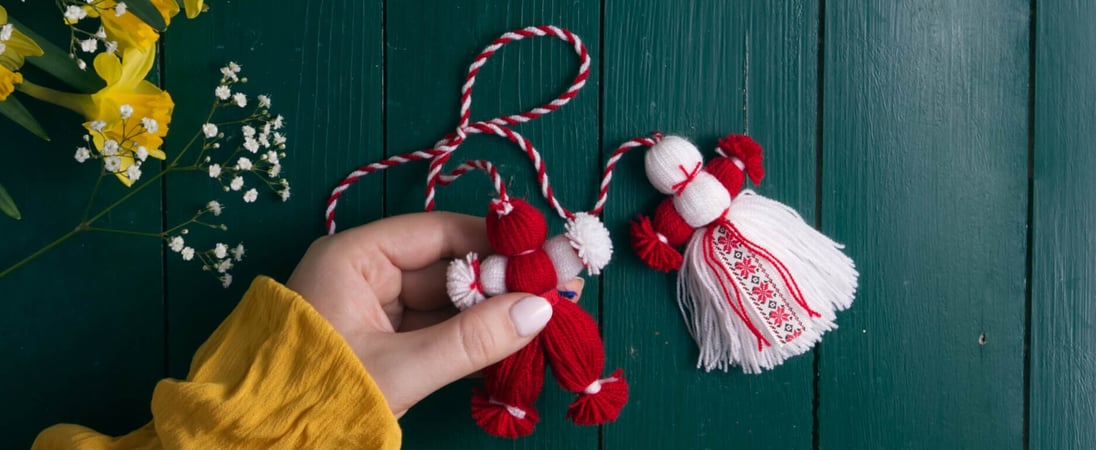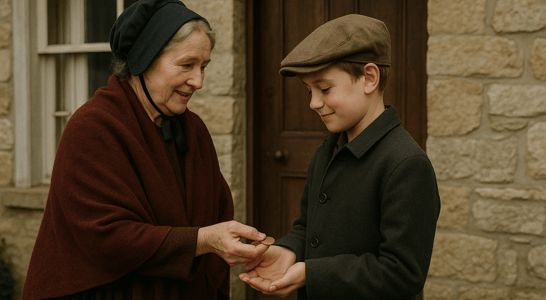
Baba Marta Day
Baba Marta Day, celebrated in Bulgaria, is a lively and colorful tradition that marks the transition from winter to spring.
People exchange and wear red and white bracelets called martenitsas. These simple yet meaningful tokens symbolize good health, happiness, and the hope for a fruitful year ahead.
The festive spirit fills the air as people pin these vibrant ornaments on their clothing or hang them from trees. The celebration reflects the joy and optimism of a new season, with everyone eagerly awaiting the first signs of spring, such as blooming flowers or the sight of a stork flying by.
How to Celebrate Baba Marta Day
Celebrating Baba Marta Day offers a delightful mix of fun traditions and good vibes. Whether you’re in Bulgaria or just want to join in the festivities, here are a few playful ways to enjoy this day.
Craft and Gift Martenitsas
Whip out some red and white yarn and get crafty! Make your own martenitsas to share with family and friends.
These little charms, in the form of bracelets or yarn dolls, are not just decorations—they’re symbols of health and happiness. Remember, never make one for yourself; they’re meant to be gifted as a sign of goodwill and connection.
Decorate a Blooming Tree
Once you’ve spotted the first signs of spring, like a blossoming tree or a stork in flight, take off your martenitsa and hang it on a tree branch.
It’s a lovely way to welcome the new season and add a splash of color to nature. You’ll see trees dotted with red and white threads, making the landscape look festive and vibrant.
Share Stories and Legends
Gather around and swap tales about Baba Marta, the quirky old lady who controls the weather. Her moods are said to influence whether March days are sunny or stormy.
Sharing these stories adds a touch of folklore magic to the day and makes it a fantastic cultural exchange if you’re celebrating with friends who are new to the tradition.
Join a Local Parade or Dance
In some towns, people celebrate with lively parades and traditional dances. If you’re in Bulgaria, look out for kukeri—people dressed in elaborate costumes with bells, meant to scare away evil spirits. It’s a thrilling sight and a fun way to immerse yourself in the local culture.
Don’t be shy; join in the fun and dance along.
Enjoy a Spring Picnic
Pack a picnic basket and head outdoors. Enjoy the fresh air and celebrate the arrival of warmer weather. Share some traditional Bulgarian treats like banitsa or lukanka with your friends, and toast to good health and a prosperous year ahead.
It’s a simple yet joyous way to embrace the spirit of the season.
With these fun and festive ideas, Baba Marta Day can be celebrated wherever you are. Just grab some yarn, gather your friends, and let the spring festivities begin!
Learn About Baba Marta Day
The unique charm of Baba Marta Day lies in the stories behind it. Baba Marta, or “Grandmother March,” is a mythical figure believed to control the weather, reflecting her moods. When she smiles, the sun shines; when she’s angry, the cold returns.
This playful personification of spring’s unpredictable nature adds a whimsical touch to the celebration. The tradition of gifting martenitsas to friends and family is a way of spreading cheer and connecting with loved ones.
It’s a day that fills the country with bright colors, hope, and the shared anticipation of warmer days to come.
History of Baba Marta Day
Baba Marta Day’s origins are shrouded in mystery, but the tradition dates back many centuries, possibly even millennia. Some people believe it originated from ancient pagan customs tied to the arrival of spring and the end of winter.
The holiday is closely associated with the figure of Baba Marta, or “Grandma March,” a character from Bulgarian folklore known for her unpredictable mood swings. When she is happy, the weather is warm and sunny, but if she is angry, the cold lingers longer.
Some Legends Associated with Baba Marta Day
One popular legend suggests that the tradition began during the time of Khan Asparuh, who founded the First Bulgarian Empire in the 7th century.
According to the story, Khan’s wife, Ahinora, sent him a red and white thread tied to a swallow’s leg as a wish for good health and prosperity. This gesture of love and protection evolved into the custom of exchanging martenitsas—the red and white yarn decorations we see today.
Another tale connects the red and white colors to the warriors who left their homes to fight in battles. Women would give their husbands red and white cloth strips to wear for protection and good luck. The white symbolized the pale faces of the women left behind, while the red represented the blood of the warriors.
Despite its ancient origins, the celebration has continued into modern times, making it one of the oldest ongoing traditions in Europe. The martenitsa itself, whether a bracelet or a small yarn doll, symbolizes health, happiness, and the hope for a good year ahead.
Today, Baba Marta Day is widely celebrated across Bulgaria and among Bulgarian communities around the world. People still exchange these red and white charms, wear them until they see the first signs of spring, and then tie them to blooming trees as a wish for good luck and prosperity.
Also on ...
View all holidaysNational Barista Day
They create magic in a cup, transforming simple beans into a delicious pick-me-up. From latte art to custom blends, they're the coffee wizards!
Share a Smile Day
Spreading happiness with a simple, friendly expression, lighting up someone's day with warmth and positivity.
National Minnesota Day
A land of lakes, forests, and vibrant cities, offering outdoor adventures, cultural delights, and a friendly spirit that's uniquely its own.







